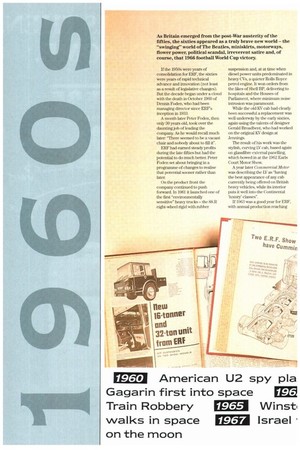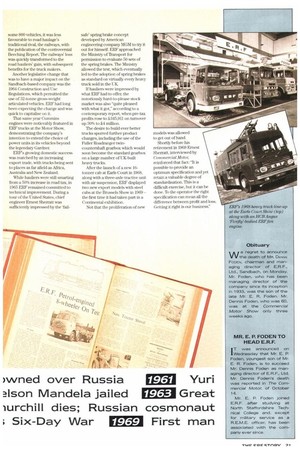As Britain emerged from the post-War austerity of the fifties,
Page 176

Page 177

If you've noticed an error in this article please click here to report it so we can fix it.
the sixties appeared as a truly brave new world — the "swinging" world of The Beatles, miniskirts, motorways, flower power, political scandal, irreverent satire and, of course, that 1966 football World Cup victory.
If the 1950s were years of consolidation for ERF, the sixties were years of rapid technical advance and innovation (not least as a result of legislative changes). But the decade began under a cloud with the death in October 1960 of Dennis Foden, who had been managing director since ERFs inception in 1933.
A month later Peter Fodert, then only 30 years old, took over the daunting job of leading the company As he would recall much later "There seemed to be a vacant chair and nobody about to fill ERF had earned steady profits during the late fifties but had the potential to do much better. Peter Roden set about bringing in a programme of changes to realise that potential sooner rather than later, On the product front the company continued to push forward. In 1961 it launched one of the first "environmentally sensitive" heavy trucks — the 88.R eight-wheel rigid with rubber
suspension and, at at time when diesel power units predominated in heavy CVs, a quieter Rolls Royce petrol engine. It won orders from the likes of Shell BP, delivering to hospitals and the Houses of Parliament, where minimum noise intrusion was paramount.
While the old KV cab had clearly been successful a replacement was well underway by the early sixties, again using the talents of designer Gerald Broadbent, who had worked on the original KV design at Jennings.
The result of his work was the stylish, curving LV cab, based again on glassflbre external panelling, which bowed in at the 1952 Earls Court Motor Show.
A year later Commercial Motor was describing the LV as "having the best appearance of any cab currently being offered on British heavy vehicles, while its interior puts it well into the Continental luxury' classes".
If 1963 was a good year for ERF, with annual production reaching some 800 vehicles, it was less favourable to road haulage's traditional rival, the railways, with the publication of the controversial Beeching Report. The railways' loss was quickly transformed to the road hauliers' gain, with subsequent benefits for the truck makers.
Another legislative change that was to have a major impact on the Sandbach-based company was the 19(34 Construction and Ilse Regulations, which permitted the use of 32-tonne gross-weight articulated vehicles. ERF had long been expecting the change and was quick to capitalise on it.
That same year Cummins engines were noticeably featured in ERF trucks at the Motor Show, demonstrating the company's intention to extend the choice of power units in its vehicles beyond the legendary Gardner.
ERF's growing domestic success was matched by an increasing export trade, with trucks being sent to places as far afield as Africa, Australia and New Zealand.
While hauliers were still smarting from a 50% increase in road tax, in 1965 ERF remained committed to technical improvement. During a tour of the United States, chief engineer Ernest Sherratt was sufficiently impressed by the Tail
safe' spring brake concept developed by American engineering company MGM to try it out for himself. ERF approached the Ministry of Transport for permission to evaluate 50 sets of the spring brakes. The Ministry allowed the test, which eventually Led to the adoption of spring brakes as standard on virtually every heavy truck sold in the UK If hauliers were impressed by what ERF had to offer, the notoriously hard-to-please stock market was also "quite pleased with what it got," according to contemporary report, when pre-tax profits nose to £345,911 on turnover up 30% to £4 million.
The desire to build ever better trucks spurred further product changes, including the use of the Fuller Roadranger twincountershaft gearbox which would soon become the standard gearbox on a large number of UK-built heavy trucks.
After the launch of a new 16tonner cab at Earls Court in 1968, along with a three-axle tractive unit with air suspension, ERF displayed two new export models with steel cabs at the Brussels Show in 1969 the first time it had taken part in a Continental exhibition.
Not that the proliferation of new
iii xiels was allowed to get out of hand.
Shortly before his retirement in 1969 Ernest Sherratt, interviewed by Commercial Motor, reinforced that fact: "It is possible to provide an optimum specification and yet retain a valuable degree of standardisation. This is a difficult exercise, but it can be done. lb the operator the right specification can mean all the difference between profit and loss. Getting it right is our business:'




































































































































































































